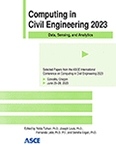From Enriched Point Cloud to Structural and MEP Models: An Automated Approach to Create Semantic-Geometric Models for Industrial Facilities
Publication: Computing in Civil Engineering 2023
ABSTRACT
While helpful for engineering applications, digital models representing the as-is status of the built environment are rarely available and costly to create using conventional methods. Commonly, editable and preferably parametric model geometries are preferred over less easy-to-process, triangulated meshes where possible; additional semantic information beyond the geometry is required in almost any case. We propose an end-to-end method starting from conventional laser-scanned point clouds including RGB color information: the captured data is processed using semantic and instance segmentation and model fitting first to identify semantic clusters and object instances, and then selected structural and MEP elements are reconstructed using geometric primitives and procedural geometric operations such as sweeps to generate meaningful, ready-to-use models. We describe all steps individually, along with a prototypical implementation in which we use state-of-the-art segmentation and reconstruction methods on a real-world dataset collected by the authors. Intermediate and final results are showcased and critically discussed.
Get full access to this article
View all available purchase options and get full access to this chapter.
REFERENCES
Agapaki, E., Miatt, G., and Brilakis, I. (2018). Prioritizing object types for modelling existing industrial facilities. Automation in Construction, 96, 211–223. https://doi.org/10.1016/j.autcon.2018.09.011.
Andriasyan, M., Moyano, J., Nieto-Julián, J. E., and Antón, D. (2020). From point cloud data to Building Information Modelling: An automatic parametric workflow for heritage. Remote Sensing, 12(7). https://doi.org/10.3390/rs12071094.
Borrmann, A., König, M., Koch, C., and Beetz, J. (2018). Building Information Modeling : Why ? What ? How ? In Borrmann A., König M., Koch C., Beetz J. (eds) Building Information Modeling. Springer, Cham. Springer. https://doi.org/https://doi.org/10.1007/978-3-319-92862-3_1.
Eberhart, R. C., and Shi, Y. (2001). Particle swarm optimization: Developments, applications and resources. Proceedings of the IEEE Conference on Evolutionary Computation, ICEC, 1, 81–86. https://doi.org/10.1109/cec.2001.934374.
Fumarola, M., and Poelman, R. (2011). Generating virtual environments of real world facilities: Discussing four different approaches. Automation in Construction, 20(3), 263–269. https://doi.org/10.1016/j.autcon.2010.08.004.
Hajian, H., and Becerik-Gerber, B. (2010). Scan to BIM: Factors Affecting Operational and Computational Errors and Productivity Loss.
Hullo, J.-F., Thibault, G., Boucheny, C., Dory, F., and Mas, A. (2015). Multi-Sensor As-Built Models of Complex Industrial Architectures. Remote Sensing, 7(12), 16339–16362. https://doi.org/10.3390/rs71215827.
Kennedy, J., and Eberhart, R. (1995). Particle swarm optimization. Proceedings of ICNN’95 - International Conference on Neural Networks, 4, 1942–1948. https://doi.org/10.1109/ICNN.1995.488968.
Liu, J., Fu, L., Cheng, G., Li, D., Zhou, J., Cui, N., and Chen, Y. F. (2022). Automated BIM Reconstruction of Full-Scale Complex Tubular Engineering Structures Using Terrestrial Laser Scanning. Remote Sensing, 14(7). https://doi.org/10.3390/rs14071659.
Noichl, F., Braun, A., and Borrmann, A. (2021). “BIM-to-Scan” for Scan-to-BIM: Generating Realistic Synthetic Ground Truth Point Clouds based on Industrial 3D Models. Proceedings of the 2021 European Conference on Computing in Construction, 2, 164–172. https://doi.org/10.35490/ec3.2021.166.
Oh, S., Lee, D., Kim, M., Kim, T., and Cho, H. (2021). Building Component Detection on Unstructured 3D Indoor Point Clouds Using RANSAC-Based Region Growing. Remote Sensing. https://www.mdpi.com/2072-4292/13/2/161?utm_source=researcher_app&utm_medium=referral&utm_campaign=RESR_MRKT_Researcher_inbound.
Pan, Y., Noichl, F., Braun, A., Borrmann, A., and Brilakis, I. (2022, July 24). Automatic creation and enrichment of 3D models for pipe systems by co-registration of laser-scanned point clouds and photos. https://doi.org/10.35490/EC3.2022.181.
Perez-Perez, Y., Golparvar-Fard, M., and El-Rayes, K. (2021). Scan2BIM-NET : Deep Learning Method for Segmentation of Point Clouds for Scan-to-BIM. Journal of Construction Engineering and Management, 147(9), 1–14. https://doi.org/10.1061/(ASCE)CO.1943-7862.0002132.
Quintana, B., Prieto, S. A., Adan, A., and Bosché, F. (2017). Scan-To-BIM for Small Building Components. I(July), 29–36. https://doi.org/10.24928/jc3-2017/0139.
Riegel, J., Mayer, W., and van Havre, Y. (2022). FreeCAD (0.20.2).
Schnabel, R., Wahl, R., and Klein, R. (2007). Efficient RANSAC for point-cloud shape detection. Computer Graphics Forum, 26(2), 214–226. https://doi.org/10.1111/j.1467-8659.2007.01016.x.
Tang, P., Huber, D., Akinci, B., Lipman, R., and Lytle, A. (2010). Automatic reconstruction of as-built building information models from laser-scanned point clouds: A review of related techniques. Automation in Construction, 19(7), 829–843. https://doi.org/10.1016/j.autcon.2010.06.007.
Thomas, H., Qi, C. R., Deschaud, J. E., Marcotegui, B., Goulette, F., and Guibas, L. (2019). KPConv: Flexible and deformable convolution for point clouds. Proceedings of the IEEE International Conference on Computer Vision, 2019-Octob, 6410–6419. https://doi.org/10.1109/ICCV.2019.00651.
Wang, B., Yin, C., Luo, H., Cheng, J. C. P., and Wang, Q. (2021). Fully automated generation of parametric BIM for MEP scenes based on terrestrial laser scanning data. Automation in Construction, 125, 103615. https://doi.org/10.1016/j.autcon.2021.103615.
Wang, Q., Guo, J., and Kim, M.-K. (2019). An application oriented scan-to-bim framework. Remote Sensing, 11(3). https://doi.org/10.3390/rs11030365.
Xie, Y., Tian, J., Zhu, X. X., and Member, S. (2019). A Review of Point Cloud Semantic Segmentation. 1–51. http://arxiv.org/abs/1908.08854.
Zhang, J., Zhao, X., Chen, Z., and Lu, Z. (2019). A Review of Deep Learning-Based Semantic Segmentation for Point Cloud. IEEE Access, 7, 179118–179133. https://doi.org/10.1109/ACCESS.2019.2958671.
Information & Authors
Information
Published In
History
Published online: Jan 25, 2024
ASCE Technical Topics:
- Buildings
- Computer networks
- Computing in civil engineering
- Design (by type)
- Engineering fundamentals
- Facilities (by type)
- Geomatics
- Geometrics
- Highway and road design
- Industrial facilities
- Mathematics
- Models (by type)
- Parameters (statistics)
- Statistics
- Structural engineering
- Structural models
- Structures (by type)
- Surveying methods
- Triangulation
Authors
Metrics & Citations
Metrics
Citations
Download citation
If you have the appropriate software installed, you can download article citation data to the citation manager of your choice. Simply select your manager software from the list below and click Download.
